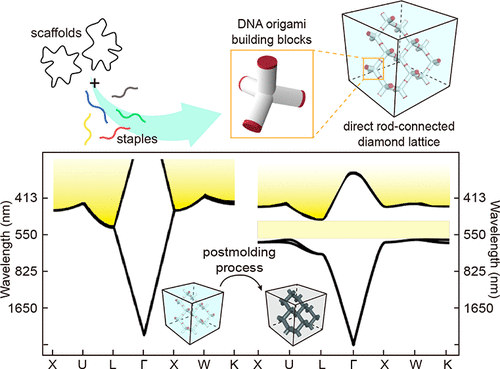当前位置:
X-MOL 学术
›
ACS Appl. Bio Mater.
›
论文详情
Our official English website, www.x-mol.net, welcomes your feedback! (Note: you will need to create a separate account there.)
Design of DNA Origami Diamond Photonic Crystals
ACS Applied Bio Materials ( IF 4.7 ) Pub Date : 2020-01-07 , DOI: 10.1021/acsabm.9b01171 Sung Hun Park , Haedong Park , Kahyun Hur 1 , Seungwoo Lee
ACS Applied Bio Materials ( IF 4.7 ) Pub Date : 2020-01-07 , DOI: 10.1021/acsabm.9b01171 Sung Hun Park , Haedong Park , Kahyun Hur 1 , Seungwoo Lee
Affiliation

|
Self-assembled photonic crystals have proven to be a fascinating class of photonic materials for nonabsorbing structural colorizations over large areas and in diverse relevant applications, including tools for on-chip spectrometers and biosensors, platforms for reflective displays, and templates for energy devices. The most prevalent building blocks for the self-assembly of photonic crystals are spherical colloids and block copolymers (BCPs) because of the generic appeal of these materials, which can be crafted into large-area 3D lattices. However, because of the intrinsic limitations of these structures, these two building blocks are difficult to assemble into a direct rod-connected diamond lattice, which is considered to be a champion photonic crystal. Here, we present a DNA origami-route for a direct rod-connected diamond photonic crystal exhibiting a complete photonic bandgap (PBG) in the visible regime. Using a combination of electromagnetic, phononic, and mechanical numerical analyses, we identify (i) the structural constraints of the 50 megadalton-scale giant DNA origami building blocks that could self-assemble into a direct rod-connected diamond lattice with high accuracy, and (ii) the elastic moduli that are essentials for maintaining lattice integrity in a buffer solution. A solution molding process could enable the transformation of the as-assembled DNA origami lattice into a porous silicon- or germanium-coated composite crystal with enhanced refractive index contrast, in that a champion relative bandwidth for the photonic bandgap (i.e., 0.29) could become possible even for a relatively low volume fraction (i.e., 16 vol %).
中文翻译:

DNA折纸金刚石光子晶体的设计
自组装光子晶体已被证明是一类令人着迷的光子材料,可用于大面积和各种相关应用中的非吸收结构着色,包括片上光谱仪和生物传感器工具、反射显示器平台和能源设备模板。用于光子晶体自组装的最普遍的构件是球形胶体和嵌段共聚物 (BCP),因为这些材料具有普遍吸引力,可以制成大面积的 3D 晶格。然而,由于这些结构的固有局限性,这两个构件很难组装成直接棒连接的金刚石晶格,这被认为是冠军光子晶体。这里,我们提出了一种直接杆连接的金刚石光子晶体的 DNA 折纸路线,该晶体在可见光范围内表现出完整的光子带隙 (PBG)。结合电磁、声子和机械数值分析,我们确定了 (i) 50 兆道尔顿级巨型 DNA 折纸构件的结构限制,这些构件可以高精度地自组装成直接杆连接的金刚石晶格,以及(ii) 在缓冲溶液中保持晶格完整性所必需的弹性模量。溶液成型工艺可以将组装好的 DNA 折纸晶格转变为具有增强的折射率对比度的多孔硅或锗涂层复合晶体,因为光子带隙的相对带宽(即 0.
更新日期:2020-01-07
中文翻译:

DNA折纸金刚石光子晶体的设计
自组装光子晶体已被证明是一类令人着迷的光子材料,可用于大面积和各种相关应用中的非吸收结构着色,包括片上光谱仪和生物传感器工具、反射显示器平台和能源设备模板。用于光子晶体自组装的最普遍的构件是球形胶体和嵌段共聚物 (BCP),因为这些材料具有普遍吸引力,可以制成大面积的 3D 晶格。然而,由于这些结构的固有局限性,这两个构件很难组装成直接棒连接的金刚石晶格,这被认为是冠军光子晶体。这里,我们提出了一种直接杆连接的金刚石光子晶体的 DNA 折纸路线,该晶体在可见光范围内表现出完整的光子带隙 (PBG)。结合电磁、声子和机械数值分析,我们确定了 (i) 50 兆道尔顿级巨型 DNA 折纸构件的结构限制,这些构件可以高精度地自组装成直接杆连接的金刚石晶格,以及(ii) 在缓冲溶液中保持晶格完整性所必需的弹性模量。溶液成型工艺可以将组装好的 DNA 折纸晶格转变为具有增强的折射率对比度的多孔硅或锗涂层复合晶体,因为光子带隙的相对带宽(即 0.


























 京公网安备 11010802027423号
京公网安备 11010802027423号